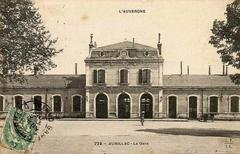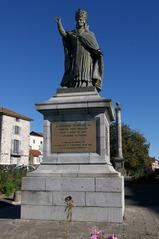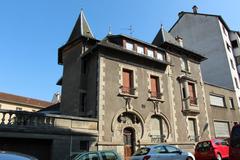Abbatiale Saint-Géraud d’Aurillac: Complete Guide to Visiting Hours, Tickets, History & Cultural Significance
Date: 04/07/2025
Introduction
Nestled in the heart of Aurillac, France, the Abbatiale Saint-Géraud d’Aurillac stands as a monument to over a millennium of spiritual, architectural, and cultural history. Founded around 885 by Géraud d’Aurillac, the abbey has evolved from a medieval pilgrimage center into a beacon of community identity and a must-see historical landmark. This guide offers a detailed exploration of the abbey’s origins, architectural evolution, and pivotal moments, while providing up-to-date information on visiting hours, ticketing, accessibility, guided tours, and nearby attractions. Whether you are a history enthusiast, a spiritual pilgrim, or a traveler eager to experience Aurillac’s heritage, the Abbatiale Saint-Géraud will offer a rich, immersive journey into France’s past. (Compagnons d’Orlhac, France Voyage, Pays d’Aurillac Tourisme)
Historical Overview
Foundation and Early Development
Founded in the late 9th century by the nobleman Géraud d’Aurillac, the abbey rapidly became a center of religious influence and learning. Géraud secured royal protection from King Charles the Simple, ensuring the abbey’s security and autonomy. The abbey’s first abbot, Adalgaire, was appointed in 898, initiating a tradition of monastic scholarship.
After Géraud’s death in 909, his tomb attracted numerous miracles, positioning the abbey as a prominent pilgrimage destination. The original church, consecrated in 972, was expanded to accommodate the growing number of pilgrims, further solidifying its spiritual and economic significance. (Compagnons d’Orlhac, France Voyage)
Medieval Expansion and Political Influence
By the high Middle Ages, the abbey exercised substantial religious, economic, and political power. It managed numerous priories and properties throughout Auvergne and into Spain. The church was notably consecrated by Pope Urban II in 1096, further enhancing its prestige. The abbey’s role extended beyond religion; it contributed to civic development, urban expansion, and trade, influencing the formation of the local bourgeoisie and the very identity of Aurillac (France Voyage).
Architectural Evolution
The abbey’s architecture reflects its long history, blending Romanesque foundations with later Gothic and Baroque additions. Original features include a three-bay nave, bell tower porch, and choir with ambulatory, while the 13th and 14th centuries saw expanded chapels and the addition of vaulted ceilings. The Wars of Religion and French Revolution inflicted significant damage, leading to substantial 19th-century restorations by Lassus and Lisch, including a new façade and bell tower. Recent archaeological work has revealed extensive Carolingian-era ruins, highlighting the abbey’s original scale and importance (POP Culture Gouv).
Conflict, Decline, and Modern Restoration
Throughout its history, the abbey faced political and religious turmoil. It was attacked during local uprisings in the 12th and 13th centuries and suffered during the Wars of Religion, notably in 1569. The French Revolution saw its dissolution and partial destruction, though the church itself survived and was remodeled in the 19th century (Archives Cantal). Ongoing preservation efforts, including a major restoration project, ensure its continued prominence as a cultural and historical site (Aurillac.fr).
Visiting Abbatiale Saint-Géraud d’Aurillac: Essential Information
Location and Access
- Address: Place Saint-Géraud, 15000 Aurillac, France
- GPS Coordinates: 44.9319664, 2.4477157
- Centrally located in the historic district; accessible on foot from the city center and train station
- Parking available nearby; much of the old town is pedestrianized (France This Way)
Opening Hours
- General Visiting: Tuesday to Sunday, 10:00 AM – 6:00 PM (closed Mondays and major holidays)
- Religious Services: Updated schedules available on the parish website
- Summer Season: Extended opening hours and additional events
Tickets and Admission
- General Admission: €5
- Reduced Admission: €3 (students, seniors)
- Children under 12: Free
- Ticketing: Available on-site and online via local tourism platforms
- Note: Entry may be free for general visits; special tours and events may require tickets (Pays d’Aurillac Tourisme)
Guided Tours and Events
- Guided Tours: Offered daily at 11:00 AM and 3:00 PM (advance booking recommended)
- Special Events: Medieval fairs, concerts, religious festivals (notably the Feast of Saint Géraud on October 13th)
- Organ Concerts: Featuring the historic 1779 Joseph Rabiny organ
Accessibility & Visitor Amenities
- Accessibility: Wheelchair accessible to main areas; some historic sections may have limited access
- Restrooms: Public facilities available nearby
- Shops and Cafés: Numerous options within walking distance, especially around Place du Square
- Photography: Permitted for personal use; avoid flash and be respectful during services
- Languages: Informational materials primarily in French; some English support at the tourism office
What to See: Key Features and Artifacts
- Romanesque and Gothic Architecture: The surviving transept, chevet, chapels, and nave highlight the abbey’s architectural evolution
- The Tau Cross: A rare 12th-century artifact, symbolizing the abbey’s spiritual heritage
- Stained Glass Windows: Mixture of medieval fragments and 19th-century replacements, illustrating religious scenes
- Sculpted Capitals: Columns topped with intricate carvings of biblical narratives and animals
- Crypt and Relics: Crypt houses relics of Saint Géraud and offers a tranquil space for reflection
- Historic Organ: The 18th-century Rabiny organ, used for concerts and religious ceremonies
- Chapels and Chapiteaux: Each chapel features unique religious artworks and sculpted capitals
- Medieval Frescoes: Remnants of wall paintings depicting biblical scenes and local legends
Surrounding Area & Nearby Attractions
- Place Saint-Géraud: Central square with historic buildings, including the former abbey hospital and a serpentine stone basin
- Aurillac Old Town: Characterized by narrow streets, half-timbered houses, and vibrant markets
- Château Saint-Étienne: Historic castle with panoramic views and the Museum of the Volcanoes
- Musée d’Art et d’Archéologie: Exhibits on regional history and art
- Notre-Dame-aux-Neiges: Another notable local church
For a comprehensive city tour, join local walking tours that include stops at these sites (Pays d’Aurillac Tourisme, Cityzeum).
Religious and Cultural Legacy
The abbey remains a living monument—hosting regular religious services, concerts, and community events. Its role as a pilgrimage site, especially on Saint Géraud’s feast day, continues to attract visitors. The abbey’s legacy also lives on in the city’s cultural life, with educational programs and ongoing restoration ensuring its preservation for future generations (Archives Cantal, Aurillac.fr).
Frequently Asked Questions (FAQ)
Q: What are the current visiting hours?
A: Generally Tuesday–Sunday, 10:00 AM–6:00 PM; closed Mondays.
Q: Is there an admission fee?
A: General admission is €5; reduced rates and free entry for children under 12. Donations are welcome.
Q: Are guided tours available?
A: Yes, daily at 11:00 AM and 3:00 PM during the tourist season.
Q: Is the abbey accessible for visitors with disabilities?
A: Main areas are accessible; some historic sections have limited access.
Q: Can I attend Mass or other religious services?
A: Yes, schedules are available on the parish website.
Q: Can I take photos inside?
A: Yes, but avoid flash and be respectful during services.
Contact Information & Official Links
- Parish Office: 22 rue du Monastère, 15000 Aurillac, France
- Phone: +33 (0)4 71 48 27 16
- Email: [email protected]
- Tourist Office: Pays d’Aurillac Tourisme
- Official Parish Website: https://www.paroissestgeraud.fr/
- Official Tourism Portal: https://www.aurillac-tourisme.com
Plan Your Visit
For the latest updates on opening hours, guided tours, and events, check the official parish or tourism websites. Download the Audiala app for guided tours, event notifications, and exclusive content. Explore more about Aurillac’s heritage through related articles and social media channels.
Summary
The Abbatiale Saint-Géraud d’Aurillac is a testament to the enduring power of faith, history, and community in the Auvergne region. From its foundation in the 9th century to its role as a living monument today, the abbey invites visitors to engage with centuries of religious and cultural heritage. Its architectural splendor, treasured relics, and vibrant cultural life ensure a memorable and enlightening visit.
Plan your journey, explore the abbey’s rich history, and immerse yourself in the unique atmosphere of Aurillac.
Sources:
Compagnons d’Orlhac, France Voyage, POP Culture Gouv, Archives Cantal, France This Way, Pays d’Aurillac Tourisme, Cityzeum, Aurillac.fr



